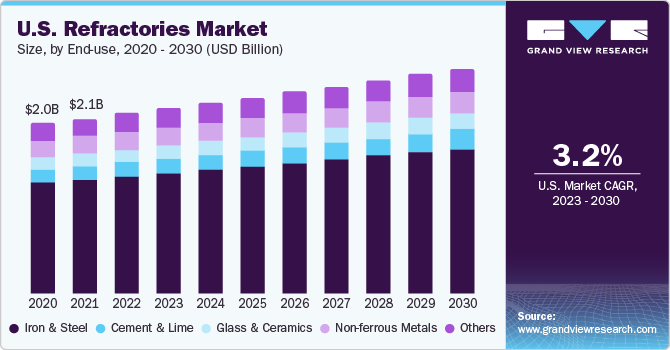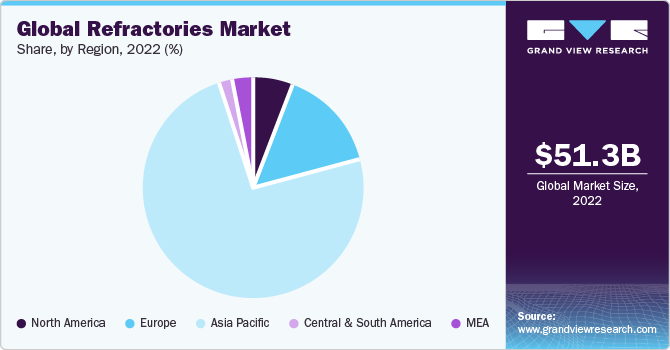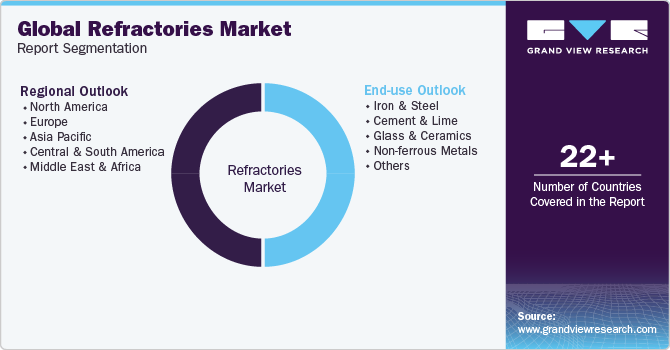- Home
- »
- Advanced Interior Materials
- »
-
Refractories Market Size, Share And Growth Report, 2030GVR Report cover
![Refractories Market Size, Share & Trends Report]()
Refractories Market Size, Share & Trends Analysis Report By End-use (Iron & Steel, Cement & Lime, Glass & Ceramics, Non-Ferrous Metals), By Region, And Segment Forecasts, 2023 - 2030
- Report ID: GVR-4-68040-141-3
- Number of Report Pages: 85
- Format: PDF, Horizon Databook
- Historical Range: 2018 - 2021
- Forecast Period: 2023 - 2030
- Industry: Advanced Materials
Refractories Market Size & Trends
The global refractories market size was estimated at USD 51.35 billion in 2022 and is projected to expand at a compound annual growth rate (CAGR) of 3.8% from 2023 to 2030. The market expansion can be attributed to the moderate to high demand for refractories from various industries such as iron & steel and cement. Refractory products are ceramic materials that can withstand high temperatures and are generally found in the linings of hot surfaces in several industrial processes. Moreover, they can also resist corrosion and wear due to chemical agents. Refractories are present in various shapes and sizes and can be utilized in different forms for applications including ladles, walls, boilers, and floors.

Refractories are produced from different synthetic and natural materials, commonly non-metallic or a combination of minerals and compounds such as bauxite, fireclay, alumina, silica, magnesite, dolomite, chromite, zirconia, silicon carbide among others. Among these, alumina, silica, and magnesite are the key materials for the production of refractory materials.
Investments in the steel industry, along with a moderate rise in crude steel production over the long term, are projected to fuel the demand for refractories in the U.S. For instance, in May 2023, JSW Steel USA announced an investment of USD 145 million to upgrade its manufacturing capabilities at Mingo Junction, Ohio. The investment is in line with the company’s long-term Environmental, Social, and Governance (ESG) goals.
Leading producers are involved in CO2 emission reduction during refractory production. For example, RHI Magnesita has developed an innovative proprietary technology that pushes the use of secondary raw materials while maintaining performance. As of December 2021, the company’s usage of secondary raw materials remains at 6.1% of total raw material input. The company is utilizing different approaches to realize long-term sustainability goals. For instance, it is developing a new solution to capture and store the carbon dioxide emitted during refractory production. The company is also developing refractory products that allow the de-carbonization of steel for the electric arc furnace route.
Regional Insights
Asia Pacific accounted for the largest revenue share of more than 73% in the global market in 2022. The regional demand is mainly supported by a moderate growth in the production of steel and cement, along with the expansion of the glass industry. In July 2023, the Xinyi Group from China announced an investment of USD 11 billion in the quartz sand industry in Batam, Indonesia. This will enable integration in the supply chain, allowing a smooth flow of raw materials.

Focus on green energy is expected to benefit the expansion of the solar glass sector, thus promoting the usage of refractory products. For instance, in August 2023, Vishakha Group commenced a glass manufacturing plant in Gujarat, India. The plant is equipped with a 660 tpd solar glass furnace and has a capacity of 4 GW. In September 2023, Corning also announced a new glass manufacturing plant in Telangana, India, with an investment of USD 113 million.
Europe region is likely to observe sluggish demand over the short term as the market has been witnessing volatility on account of rising energy costs and disrupted supply chains amidst the Russia-Ukraine war. The iron and steel industry is the major consumer of refractory products in the region. As per the European Steel Association, crude steel production in the European Union reached 136,321 million tons in 2022 compared to 152,782 million tons in 2021.
End-use Insights
In terms of end-use, the iron & steel segment held the largest revenue share of over 64% in 2022 globally. The demand in this segment is expected to remain low to moderate on account of crude steel production. In 2022, crude steel production declined by 4.3% on a y-o-y basis, as reported by the World Steel Association, thus impacting the refractories demand during the same period.
The share of refractory products in glass manufacturing is expected to decline over the coming years. Modern float and container glass furnaces have an average lifespan of about 12 to 15 years; with modern technology, the life of these furnaces is anticipated to increase over the coming years. Thus, the demand for refractories is likely to be low in the glass industry over the coming years.
In the cement industry, refractory products are used to protect the steel shell from heat and gas temperature to allow it to work at the required temperature. Thus, growing investments in construction & infrastructure are projected to support cement production and eventually benefit market growth in coming years. However, as per the IEA, global cement production observed a fall of 5% in 2022, impacted by real estate sluggishness and COVID-related disruptions in China.
Key Companies & Market Share Insights
The global market is unorganized, with a presence of few international players and several regional players. The competition in this space has been impacted by the availability of a wide range of refractory products from leading producers and the entrance of specialized manufacturers. This has reduced the specific consumption for different end-use industries, such as steel and glass. For instance, the specific consumption of refractories in India for the glass industry reached 5.4 kg per ton in 2018, with a reduction of 3 kg per ton since 2009 - 10 levels.
Penetration of fused cast refractories is likely to provide new sales avenues for market participants. These products are manufactured using casting and electro-fusing processes. These products offer advantages such as abrasion and corrosion resistance, durability, and stable composition and are used in glass furnaces, sidewalls, tank blocks, and superstructures among others.
Key Refractories Companies:
- Chosun Refractories Co., Ltd.
- Coorstek Incorporated
- HarbisonWalker International
- Imerys
- Krosaki Harima
- Morgan Advanced Materials
- RHI Magnesita
- Saint-Gobain SEFPRO
- Shinagawa Refractories
- Vesuvius
Refractories Market Report Scope
Report Attribute
Details
Market size value in 2023
USD 52.79 billion
Revenue forecast in 2030
USD 68.54 billion
Growth Rate
CAGR of 3.8% from 2023 to 2030
Base year for estimation
2022
Historical data
2018 - 2021
Forecast period
2023 - 2030
Quantitative Units
Volume in kilotons, revenue in USD million/billion and CAGR from 2023 to 2030
Report coverage
Volume & revenue forecast, competitive landscape, growth factors, and trends
Segments covered
End-use, region
Regional scope
North America; Europe; Asia Pacific; Central & South Africa; Middle East & Africa
Country scope
U.S.; Canada; Mexico; Germany; UK; France; Russia; China; Japan; India; South Korea; Brazil; South Africa,
Key companies profiled
Chosun Refractories Co., Ltd.; Coorstek Incorporated; HarbisonWalker International; Imerys; Krosaki Harima; Morgan Advanced Materials; RHI Magnesita; Saint-Gobain SEFPRO; Shinagawa Refractories; Vesuvius
Customization scope
Free report customization (equivalent up to 8 analysts working days) with purchase. Addition or alteration to country, regional & segment scope.
Pricing and purchase options
Avail customized purchase options to meet your exact research needs. Explore purchase options
Global Refractories Market Report Segmentation
This report forecasts revenue and volume growth at global, regional, and country levels and provides an analysis of the latest industry trends in each of the sub-segments from 2018 to 2030. For this study, Grand View Research has segmented the global refractories market report based on end-use and region.

-
End-use Outlook (Volume, Kilotons; Revenue, USD Million, 2018 - 2030)
-
Iron & Steel
-
Cement & Lime
-
Glass & Ceramics
-
Non-ferrous metals
-
Others
-
-
Regional Outlook (Volume, Kilotons; Revenue, USD Million, 2018 - 2030)
-
North America
-
U.S.
-
Canada
-
Mexico
-
-
Europe
-
Germany
-
UK
-
France
-
Russia
-
-
Asia Pacific
-
China
-
Japan
-
India
-
South Korea
-
-
Central & South America
-
Brazil
-
-
Middle East & Africa
-
South Africa
-
-
Frequently Asked Questions About This Report
b. The global refractories market size was estimated at USD 51.35 billion in 2022 and is expected to reach USD 52.79 billion in 2023.
b. The global refractories market is expected to grow at a compound annual growth rate of 3.8% from 2023 to 2030 to reach USD 68.54 billion by 2030.
b. Based on end-use segment, iron & steel held the largest revenue share of more than 64.0% in 2022 owing to consistent demand for steel products from end-use industries such as construction, automotive & machinery
b. Some of the key vendors of the global refractories market are Chosun Refractories Co., Ltd., Coorstek Incorporated, HarbisonWalker International, Imerys, Krosaki Harima, Morgan Advanced Materials, RHI Magnesita, Saint-Gobain SEFPRO, Shinagawa Refractories and Vesuvius
b. Growing demand for steel, cement, and glass on account of investments in real estate & infrastructure over the long term is projected to drive the refractories market growth.
Share this report with your colleague or friend.
![gvr icn]()
NEED A CUSTOM REPORT?
We can customize every report - free of charge - including purchasing stand-alone sections or country-level reports, as well as offer affordable discounts for start-ups & universities. Contact us now
![Certified Icon]()
We are GDPR and CCPA compliant! Your transaction & personal information is safe and secure. For more details, please read our privacy policy.
We are committed towards customer satisfaction, and quality service.
"The quality of research they have done for us has been excellent."





